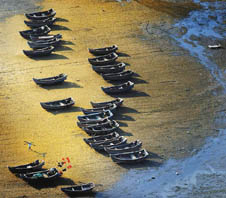|
China is a typical agrarian society, and therefore values the environment highly. In the second century B.C., Emperor Jingdi of the Han Dynasty held that cereals, silk and hemp were more valuable and useful than gold and jewelry. Agriculture began to flourish in China more than 3,000 years ago. By the third century B.C. the scale of agriculture was little different from the present day. But in its early stages, slash-and-burn cultivation was practiced, greatly damaging the country’s ecology, while the Yellow River, one of the cradles of Chinese civilization, frequently burst its banks, inundating the surrounding countryside. Gradually, however, the spirit of nature preservation deepened and spread to become one of the central features of Chinese agriculture.
It is said that more than 4,000 years ago, official positions were established to administer the country’s natural resources. During the pre-Qin period (21st century-221 B.C.) such official positions were systematically delineated specifying a range of responsibilities, from those in charge of mountains, to those responsible for rivers and forests.
The duties of such officials included drafting rules to protect the environment and the country’s ecological resources, and recording official regulations. The Book of Rites cites regulations regarding how to utilize natural resources in every month and season. According to the regulations, in spring, tree felling was prohibited except for making coffins. Felling trees during their growing period was prohibited in order to preserve the forests. In hunting and fishing, draining ponds to catch all the fish was prohibited, while turning forests into farmland by burning trees was also banned. Hunting animals during their mating periods was proscribed, as was the hunting and killing of young animals. In agricultural cultivation, the ancients mastered crop rotations and intercropping. By applying these methods, farmlands are still suitable for cultivation, even after 10,000 years of tilling.
The Unity of Heaven and Man
 |
|
Fishing boats on Xiapu coastal beach during the fishing moratorium. |
The period between the eighth century B.C. and the third century B.C. saw the flourishing of Chinese philosophy. Almost all of the philosophies that have had a profound influence on Chinese culture took shape during this period. It is interesting to note that the concept of “unity of heaven and man” was advocated by almost every school of philosophy, though each school had its own emphasis. For instance, Taoists advocated the absolute protection of nature, while Confucians held that what humans take from nature should be within proper limitations.
|
